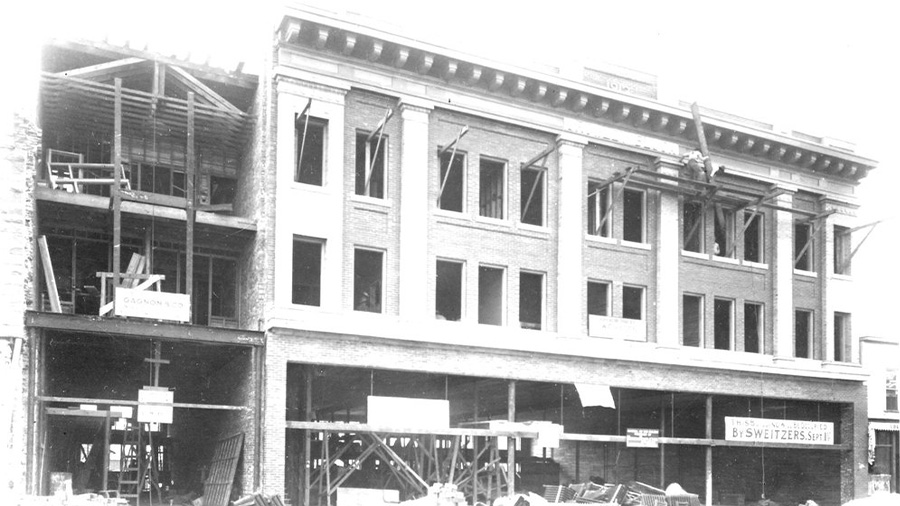ADAPTIVE REUSE AND HISTORIC PRESERVATION: WHAT IS IT AND WHAT DOES IT TAKE?
Adaptive reuse is a sustainable building practice that minimizes carbon impact by repurposing existing structures for new use and giving a second life to building materials. Historic preservation takes this a step further by repurposing historic buildings while preserving the fabric of our communities for generations to come.
Homeword has completed four projects that include the adaptive reuse of historic buildings. These include Acme in Billings, Lenox Flats in Missoula, Ouellette Place in Lewistown and Bluebunch Flats in Livingston. Right now, we are working on two more: Crowley Flats in Lewistown and Baatz Block in Great Falls, both originally built in 1913.
It isn’t easy work. For each historic project, there are numerous criteria to meet, steps to complete and unique challenges.
First, we must list the building on the National Register of Historic Places to access equity from the sale of Historic Tax Credits. Since the equity can be a significant amount on a multi-million-dollar development project, it impacts the financial feasibility of the project. Historic Tax Credits also provide an incentive for owners to preserve the significant features when it might be less expensive to simply tear them out and replace them with new materials.
There are four criteria established by the National Park Service that make a building eligible for the National Register of Historic Places. The building must:
- Be associated with events that have made a significant contribution to the broad patterns of our history; or
- Be associated with the lives of persons significant in our past; or
- Embody the distinctive characteristics of a type, period or method of construction, or that represent the work of a master, or that possess high artistic values or that represent a significant and distinguishable entity whose components may lack individual distinction; or
- Have yielded, or may likely yield, information important in prehistory or history.
In addition, properties must possess a high degree of integrity to qualify for listing in the Register. In other words, they must be relatively unchanged in appearance from the historic period.
The next step after getting the building listed on the National Register of Historic Places and establishing funding through historic tax credits is to submit forms to the National Park Service through our State Historic Preservation Office (SHPO). In these forms we identify the important physical characteristics of the building. This is typically the exterior of the building, especially windows, doors and exterior building materials like stone or masonry and any decorative features like the pattern of the brick, cast stone or terracotta window surrounds. On the interiors, we must generally preserve the circulation pattern—open stairs and primary hallways—and any decorative or unique elements.
We also detail in the forms how we will rehabilitate and preserve and, in some cases, restore the significant features. If original windows still exist for example, we preserve and restore them. Even though the old wood or metal windows might not be as energy-efficient as new windows, preserving the historical nature is valued more than energy efficiency in an historic project. To enhance the energy conservation of these preserved windows, we can install storm windows or double-glazing. If original window openings were filled in with masonry or siding, we must make all attempts to restore those openings. Another goal is to add insulation and sheetrock on the inside of exterior walls, which often are not insulated at all.
Other complications of historic adaptive reuse can be similar with rehabbing any older building. There is likely to be lead-based paint, materials containing asbestos, mold and mildew. On occasion, there are other hazards such as pigeon droppings or even bobcat scat that must be cleaned out of the building to make it safe.
An exciting part of this, however, is that hidden treasures can emerge during the process of adapting and preserving historic buildings. Sometimes we find old newspapers with historic events, old brass hardware and handcrafted decorative elements. These objects may not have been visible before selective demolition began but can be highlights when rehabilitation is complete.
Finally, after the project is complete, we certify that we did all the things we promised to do to preserve the historic significance of the building. We provide before and after pictures, showing how we implemented the proposed work.
Despite the challenges, adaptive reuse and historic preservation is extremely rewarding. It allows us to protect and share part of a community’s history and culture that may otherwise have been lost forever while also providing charming places for people to live.
Julie Stiteler for Homeword’s Development Team







